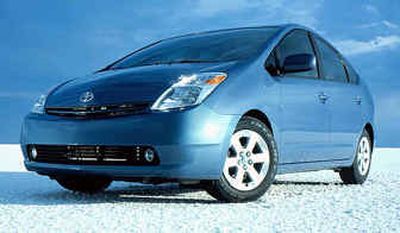Prius Hybrid’s so popular, orders backlogged

Toyota drove off with eight major awards for its second-generation Prius Hybrid in 2004, but still found room for a few improvements in the 2005 model — the small list of upgrades perhaps proving that it’s hard to improve on perfection.
Our amazement with this hybrid sedan was renewed again in our weeklong test, from its futuristic push-button, keyless start to a modern design and, oh yes, the 60 mpg city/51 mpg highway fuel rating.
Disbelievers remain, so we’ll repeat: Prius needs NO special maintenance (like being plugged in at night), does not sacrifice room or engine response and, to the driver, operates the same as any other vehicle.
The Hybrid Synergy Drive system that powers the Prius combines gasoline, electric and battery power to improve gas mileage and reduce emissions. The 1.5-liter, four-cylinder DOHC engine operates off the electric generator and battery power during times when you need minimal power (downhill, deceleration, idle). And yet, if you want to jump into the passing lane to overtake a rig, you stomp on the gas and the Prius responds.
While you don’t notice the unique engine operation or its low emissions, there are features that certainly stand out. Among them is the Smart Key Technology, which uses a transponder in the key fob to temporarily unlock the car when the person with the key gets within 3 feet of the vehicle, even if the fob is in a pocket or handbag. Once inside, the driver still doesn’t need the key to start the engine. Instead, he or she simply pushes the start button on the dash (as long as the key is nearby).
Also unique is Prius’ tiny gearshift lever, which sticks out of the dash just above the key fob hole, taking up about the same space as a fan control knob on most cars. The lever, protruding about 2 inches out of the dash, moves inside a small H-shaped slot to shift from drive to reverse, etc. The unique gearshift is made possible through By-Wire Technology, similar to that used on modern jet airplanes.
Inside the Prius, “fabric cloth seats” sound generic, but look terrific and feel even better — they’re almost like suede. Comforts and conveniences include AM/FM/CD player with six speakers; cruise control; a liquid-crystal multi-information display panel that includes an energy monitor; tilt steering wheel with climate and audio controls; and 60-40 fold-flat rear seat.
The $2,075 option that came with our tester included the Smart Key system, driver and passenger side and curtain airbags, vehicle stability control, front fog lamps and high-intensity-discharge headlamps with auto leveling feature. Fifteen-inch alloy wheels are standard.
The Prius also matches its non-hybrid competitors in safety, with driver and front passenger dual-stage airbags, traction control, anti-lock braking system, side-impact door beams, three-point seat belts and a child restraint system.
Important numbers include a 106.3-inch wheelbase, 2,890-pound curb weight and an 11.9-gallon fuel tank.
You’re never going to squeal the wheels with the Prius’ 110 net horsepower, and there has been some industry skepticism of the 51 mpg to 60 mpg fuel ratings (we were closer to the lower number, in the mid-40s).
Otherwise, there is little to fault with this vehicle, and that’s why orders are backlogged again this model year. In the end, it’s a short wait to get to the future in environmentally friendly style, so we give Prius a 9.5 on a scale of 1 to 10.
Likes: Fuel mileage, shifting system, low emissions, cloth interior.
Dislikes: Waiting to buy one.